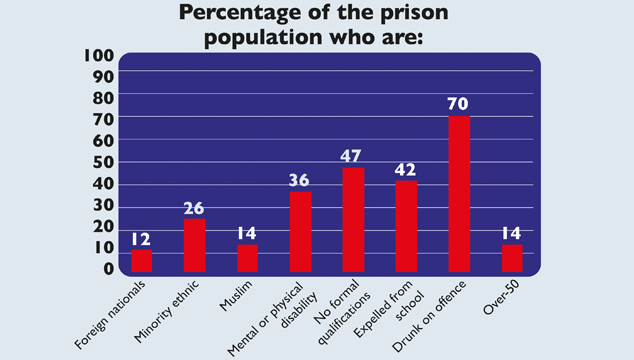
Our prisons are overcrowded and violent places – and overstretched staff can’t cope. With more budget cuts on the way, what hope is there for change? Simon Wilson reports.
What state are Britain’s prisons in?
Not good. This month, in his last report before stepping down next year, Nick Hardwick, the chief inspector of prisons, issued a bleak warning. Conditions in English and Welsh prisons have deteriorated dramatically over the past decade – they are currently “places of violence, squalor and idleness”. Staff shortages, overcrowding, and violence fuelled by the rising availability of “legal highs” have contributed to a significant decline in safety.
Hardwick also said that the “rehabilitation revolution” proposed by the coalition government in 2010 had never begun – prevented by a lack of staff to move inmates from cells to work or training. “It is hard to imagine anything less likely to rehabilitate prisoners than spending all day lying on their bunks in squalid cells watching daytime TV.”
He sounds angry?
Indeed. Since 2005, prisons have been assessed on levels of safety, respect, purposeful activity among inmates, and resettlement. This year’s report presented the worst findings so far, the “most alarming” feature being the “accelerating increase in serious assaults”.
You are more likely to die in prison than five years ago. More prisoners are murdered, kill themselves, self-harm and are victims of assaults than five years ago. Assaults on staff are up by 28% since 2010. Meanwhile, work, training, education and other “activity outcomes” were all dismal, and only “good” or “reasonably good” in 25% of the adult male prisons inspected.
In Hardwick’s view, the problem is a lack of resources. The prison population (in England and Wales) is at an all-time high of 87,000 (it has doubled over the past 25 years, despite falling crime levels), yet from March 2010 to December 2014, full-time staff numbers fell from 45,080 to 32,100. Staff are “spinning more and more plates, and they are starting to drop”, says Hardwick. “It cannot go on like this… The ball is now in the secretary of state’s court.”
What is his response?
The new secretary of state for justice is Michael Gove (replacing Chris Grayling). Last week he set out a vision for prison reform that was hailed by Will Hutton in The Observer as “bold and challenging”; by The Times as “an important step in the right direction”; and by the Howard League for Penal Reform as “a breath of fresh air”.
Gove, who had already scrapped Grayling’s ban on friends and family sending books to prisoners, proposed selling off the estate of crumbling Victorian prisons in cities and building modern ones “where the dark corners that facilitate bullying, drug-taking and violence could be increasingly designed out”. He also floated the idea of scrapping the automatic release of fixed-term prisoners halfway through their terms in favour of an “earned release” system that gives prisoners an incentive to acquire skills.
Sounds promising?
Yes, but with further budget cuts on the way, the reforms only add up financially if the prison estate sell-off pays for itself (and more), and the educational reforms result in more early releases. The National Offender Management Service has already cut its costs by 24% over the past five years, and is committed to a further cut of 10% in real terms this financial year. In terms of spending on prisons, that involves a budget cut of £263m between 2011/2012 and 2013/2014, with further cuts of £180m due by 2015/2016. In the latest year for which full figures are available (2013-2014), the average cost of a prison place was £36,237, a 3.9% cut in real terms on the previous year, and considerably lower than £45,000 in 2008-2009.
How does this compare across Europe?
England and Wales spend more per prisoner per day (£87 in 2012, according to the Council of Europe) than the European average of £72 – but not vastly more, and about the same as Germany. Northern European countries spend far more than those in the south and east. Poland spends only £14, and Greece just £2.36, whereas Sweden spends £234 and Finland £124. The main difference is that sentences in England and Wales tend to be longer, which naturally increases overall costs – 10.7% of inmates were serving life sentences, compared with a European average of 3.1% (in Northern Ireland it’s 14.1% and 15.4% in Scotland).
Only one other EU country, Greece, had a double-digit lifer population, with 10.4%. England and Wales’ prison population also has the highest proportion in the EU of offenders convicted of rape, at 7.6%. The population is older than average, has about an average proportion of women (5%), and fewer foreign prisoners than the average of 23.5%. All of which suggests that if Gove is to succeed, he will have to tackle the root cause of the explosion in prison numbers since 1993: sentencing policy.